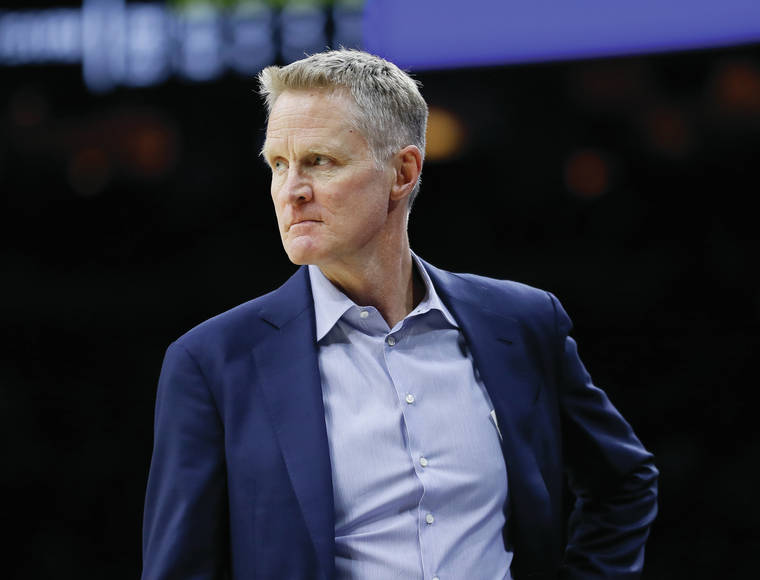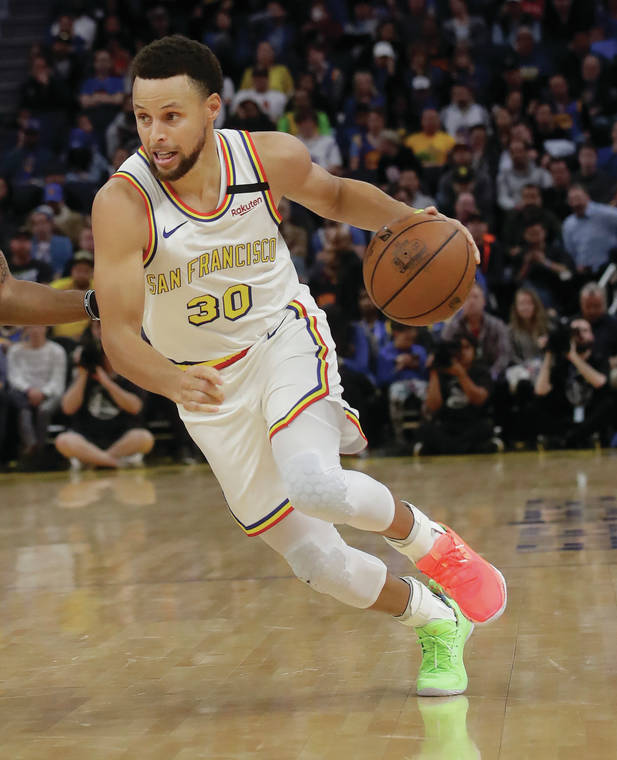For the Warriors, the NBA opener will be a reunion and a rebirth

Golden State Warriors’ Steve Kerr coaches during a Jan. 28 game against the Philadelphia 76ers. (AP Photo/Matt Slocum)

Golden State Warriors guard Stephen Curry drives against the Toronto Raptors during a March 5 game. (AP Photo/Jeff Chiu)
On Tuesday night at Barclays Center, Stephen Curry will take the floor for the Golden State Warriors, and Steve Kerr will coach the team in its first meaningful game in more than nine months. The considerable wait to get back to work is where the oddities only begin for Kerr.
On Tuesday night at Barclays Center, Stephen Curry will take the floor for the Golden State Warriors, and Steve Kerr will coach the team in its first meaningful game in more than nine months. The considerable wait to get back to work is where the oddities only begin for Kerr.
As he returns from the longest hiatus he has known in an NBA career that began when he was a rookie in 1988-89, Kerr must confront two familiar faces leading the Brooklyn Nets. He will be coaching against Kevin Durant, the co-pillar of two Warriors championship teams alongside Curry, and against a good friend, Steve Nash, who will be making his official debut as the Nets’ (and Durant’s) coach.
It is a lot to track in terms of storylines, and at the same time, it is only half the story on opening night of the NBA’s 75th season. To lead off a schedule that was moved up to begin just before Christmas, after strong urging from the league’s television partners in their quest for maximum profit, Warriors vs. Nets comes amid a pandemic that is wreaking its worst havoc yet across the United States.
“We are in the same boat as a lot of people out there,” Kerr said. “Everything is strange for everybody. We’re lucky to be working, and we recognize that. So we are embracing our circumstances rather than lamenting them.”
There figures to be enough worry to go around, from various corners of the league, even if Kerr manages to stifle his concerns. The NBA is starting anew after its shortest offseason ever and will do so in the coronavirus-ravaged real world, just 72 days removed from the Los Angeles Lakers emerging as champions from the league’s bubble at Walt Disney World near Orlando, Florida.
There will be no fans allowed inside Barclays to witness the various reunions for Kerr, Durant, Curry and Nash, but there will also be no bubble to protect the participants. The NBA is counting on daily testing of players, coaches and team staff members, vigilant mask-wearing and social distancing, and an expanded book of health and safety guidelines to get through the winter — even as public health experts project January to be the most devastating month yet in the country’s battle against the virus.
All 30 teams will also have a league-assigned “protocol officer” with them on the road and on team planes, trying to ensure adherence to the many restrictions outlined within the league’s nearly 160 pages of rules to govern the season.
Dr. Anthony Fauci, the country’s top infectious disease expert, recently predicted that access to a COVID-19 vaccine should be widespread nationally by late spring or early summer, with those who have no preexisting health conditions likely able to be vaccinated by the end of March or the beginning of April. The months until then, however, could be grim — something the NBA has essentially acknowledged by releasing only the first half of its regular-season schedule, through March 4. The league office wants to maintain calendar flexibility to deal with the sort of coronavirus-related disruptions that have upended other sports, such as the NFL and college football, which have not employed bubbles.
“We know there are going to be challenges and bumps, but so far things are good, and we’re optimistic that we have a plan that we can work through those challenges and bumps,” said David Weiss, the NBA’s vice president of player matters.
Mark Cuban, the owner of the Dallas Mavericks, said, “We won’t be able to eliminate cases and outbreaks. But if we can minimize them, then hopefully it can be as close to a normal season as possible.”
The NBA won considerable plaudits for the manner in which it engineered and orchestrated its bubble. The NFL, in stark contrast, is mere weeks removed from the fiasco of the Denver Broncos’ playing the New Orleans Saints without a recognized quarterback after a spate of coronavirus protocol violations. The reality, though, is that NBA teams — playing a high-contact, face-to-face, indoor sport that, with three to four games per week, requires much more travel — will face conditions that their NFL counterparts do not.
“We expected that the numbers would go down during this first phase of testing as people started following the protocols,” Weiss said. “At the same time, we know that doesn’t mean that we won’t have cases. We know we’re not in the clear, and we can’t get complacent. We have to stay vigilant with the protocols. That’s how we succeed.”
“The most important aspect,” Cuban said, “is that the players and staff that are traveling are treating each game as a self-imposed bubble.”
Seven of the league’s 30 teams have decided, after receiving clearance from local jurisdictions, to allow a reduced number of fans into their buildings as the season begins: Cleveland, Houston, Memphis, New Orleans, Orlando, Utah and the Toronto Raptors, who have temporarily relocated to Tampa, Florida, because the Canadian government refused to allow teams to enter the country without 14-day quarantines.
The eight teams that were not invited to the bubble, Golden State among them, have not played a game that counts for more than 280 days. The Lakers and the Miami Heat, after battling for six games in the NBA finals, were back in training camps less than eight weeks later. There will be rest and recovery inequities for numerous teams over the 72 regular-season games — down from the usual 82. The league compressed the schedule by 10 games to avoid infringing upon next summer’s rescheduled Tokyo Olympics and, most of all, to get on track for a return to its customary October-to-June calendar for the 2021-22 season.
Orlando’s Evan Fournier expressed sympathy for the ultratight turnarounds that his Lakers and Heat peers face but said, “The rest of the league, we’ve got to play.”
© 2020 The New York Times Company


